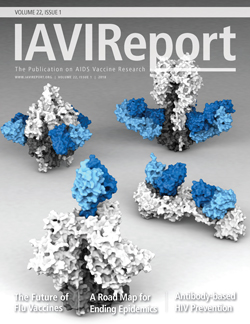November 20, 2019
IAVI REPORT – VOL. 22, NO. 1, 2018
Kristen Jill Kresge

This year’s flu season was one for the books, and it swung the spotlight directly on vaccines. The predominant strain of influenza virus that circulated in the US, an influenza A subtype known as H3N2, was particularly virulent, leaving thousands dead and sending many more to the hospital. And the seasonal flu vaccine was only modestly effective against this particular strain.
One hundred years after the worst influenza pandemic in human history, there is growing concern about how effective annual flu shots are and whether or not the world will be prepared when another pandemic strikes. The answers to these questions are troubling. But if anything, this particularly severe flu season seems to be spurring researchers and public health experts to pay more attention to this threat than ever before.
Influenza is a highly variable virus. Though much less variable than HIV, there are still possible areas of overlap between the HIV and flu vaccine research efforts. We discuss these in an article that also explores the current state of research into developing both better seasonal flu shots and vaccines that could ward off a future pandemic strain.
This issue also features an interview with Jonathan Quick, senior fellow at the non-profit Management Sciences for Health and author of the recently published book, “The End of Epidemics: The Looming Threat to Humanity and How to Stop It.” In his book and in the interview, Quick balances the looming threat that many infectious pathogens pose with a sense of hopefulness about how everyone from average citizens to government officials can do their part to help limit or even eliminate these threats in the future. In doing so, he draws many lessons from the response to HIV/AIDS.
As for HIV vaccine research, this issue features a perspective piece authored by one of IAVI’s own scientists, Devin Sok. He outlines advances in three areas of antibody-related HIV prevention research that were discussed during January’s Keystone Symposia.
On a more somber note, we also pay tribute in this issue to two dedicated and inspiring contributors to HIV research who passed away recently—David Cooper and Bonnie Mathieson. The legacies these two leave behind will continue to influence the field for a long time to come. IAVI Report recognizes their steadfast dedication to ending HIV/AIDS for all time. And though they did not live to see that shared vision become a reality, it will be because of their persistence and that of countless others that it will eventually be realized.